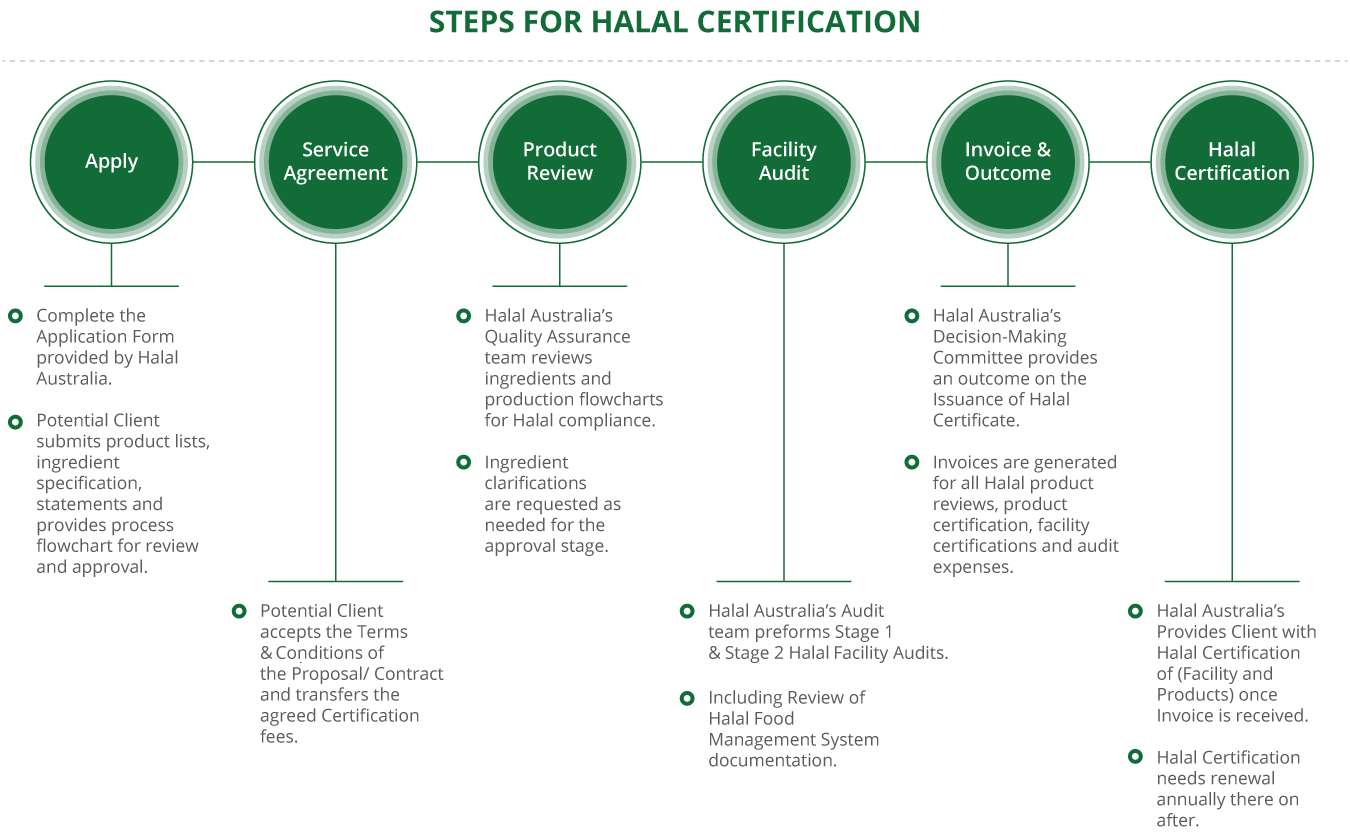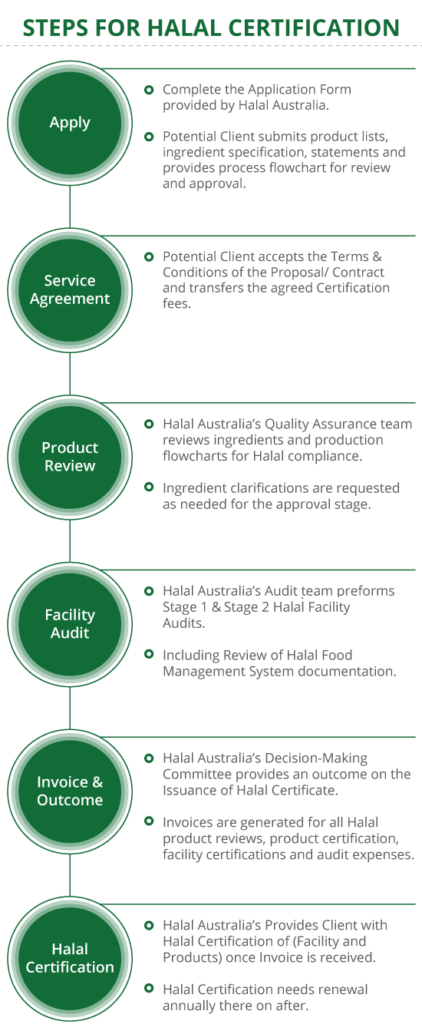STEPS FOR HALAL CERTIFICATION


Pre-requisite requirement for applying Halal Certification with Halal Australia
- No pork or pork by-products shall be used for production on any part of the Client’s premises.
- All halal processing activities are performed, and all ingredients used are halal.
- Halal Australia does not certify restaurants.
- The production facility must be free from contamination by non-Halal materials.
- Applicants must provide complete and accurate documentation, including ingredient lists, supplier Halal certificates, and process flow charts.
- All processes must comply with Islamic Shariah principles.
Certification Process:
- Application submission and Application review: Applicants must complete the Halal Certification Application Form, providing details about their company activities, products, and processes.
- Quotation & Service Agreement: Upon successful application review, a quotation and service agreement will be issued to the applicant.
- Document Review: Halal Australia auditors will review the submitted documentation, including product lists, material matrix, process flow charts, and supporting documents (e.g., raw material Halal certificates).
- On-site audit: Halal Australia auditors (Technical Auditor & Shariah Expert) will conduct an on-site audit to verify compliance with Halal requirements.
- Certification decision: Halal Australia Decision-Making Committee will review the audit report and make a certification decision.
- Issuance of the Halal Certificate: If approved, the applicant will receive a Halal Certificate and approval to use the Halal Australia logo.
Maintaining Certification:
- Annual surveillance audits to ensure ongoing compliance.
- Notification of any changes to products, processes, or ingredients.
Halal Australia Certification Schemes
- Halal Australia Halal Certification Scheme for Food, Beverages, and Raw Material Products
- OIC/SMIIC 1:2019 General Requirements for Halal Food
- UAE.S GSO 2055-1:2015 General Requirements for Halal Foods
- MS 1500:2019 Halal Food – Production, Preparation, Handling, Storage – General Guideline
- SNI 99001:2016 Halal Management System
- SNI 99004:2021 General Requirements for Halal Food
- MUIS-HC-S001 General Guidelines for the Handling and Processing Halal Food
- Halal Australia Halal Certification Scheme for Slaughtering
- OIC/SMIIC 1:2019 General Requirements for Halal Food
- GSO 993:2015 Animal Slaughtering Requirements According to Islamic Rules
- MS 1500:2019 Halal Food – Production, Preparation, Handling, Storage – General Guideline
- SNI 99002:2016 Halal Slaughtering on Poultry
- SNI 99003:2018 Halal Slaughtering on Ruminant
- SNI 6160:2022 Poultry slaughterhouse
- Halal Australia Halal Certification Scheme for Consumer Goods
- MS 2200-2:2013 Islamic Consumer Goods – Part 2 Usage Of Animal Bone, Skin and Hair – General Guideline
- Halal Australia Halal Certification Scheme for Cosmetics & Personal Care
- UAE.S 2055-4: 2014 General Requirements for Cosmetics and Personal Care
- MS 2200-1:2008 Islamic Consumer Goods – Part 1 Cosmetic and Personal Care – General Guideline
- Halal Australia Halal Certification Scheme for Pharmaceutical
- MS 2424:2019 Halal Pharmaceuticals – General Guideline
- Halal Australia Halal Certification Scheme for Logistics Service
- MS 2400-1:2010 Halalan Toyyiban Assurance Pipeline – Part 1 Mgmt System Req For Transportation Of Goods N Cargo Chain Service
- MS 2400-2:2010 Halalan Toyyiban Assurance Pipeline – Part 2 Mgmt System Req For Warehouse N Related Activities
- MS 2400-3:2010 Halalan Toyyiban Assurance Pipeline – Part 3 Mgmt System Req For Retailing
Categories of Halal Products/Services/Processes and/or Management Systems
| Cluster | Category | Subcategory | Examples of included activities | |
|---|---|---|---|---|
| Farming | A | Farming of Animals | AI - Farming of Animals for Meat/ Milk/ Eggs/ Honey |
Raising animals (other than fish and seafood) used for meat production, egg production, milk production or honey production Growing, keeping, trapping and hunting (slaughtering at point of hunting) Associated farm packing b and storage |
| AII - Farming of Fish and Seafood |
Raising fish and seafood used for meat production Growing, trapping and fishing (slaughtering at point of capture) Associated farm packing b and storage |
|||
| B | Farming of Plants | BI - Farming of Plants (other than grains and pulses) |
Growing or harvesting of plants (other than grains and pulses): horticultural products (fruits, vegetables, spices, mushrooms, etc.) and hydrophytes for food Associated farm packing b and storage |
|
| BII - Farming of Grains and Pulses |
Growing or harvesting of grains and pulses for food Associated farm packing b and storage |
|||
| Food and feed processing | C | Food | CI - Processing of perishable animal products | Production of animal products including fish and seafood, meat, eggs, dairy and fish products |
| CII - Processing of perishable plant products |
Production of plant products including fruits and fresh juices, vegetables, grains, nuts, and pulses |
|||
| Manufacturing | CIII - Processing of perishable animal and plant products (mixed products) |
Production of mixed animal and plant products including pizza, lasagne, sandwich, dumpling, ready-to-eat meals |
||
| CIV - Processing of ambient stable products |
Production of food products from any source that are stored and sold at ambient temperature, including canned foods, biscuits, snacks, oil, drinking water, beverages, pasta, flour, sugar, food-grade salt |
|||
| CV - Animal slaughtering *CI for SMIIC standards |
Processing of carcasses including slaughtering in slaughterhouses, cutting, cleaning and packing. |
|||
| D | Animal Feed Production | DI - Production of Feed | Production of feed from a single or mixed food source, intended for food-producing animals | |
| DII - Production of Pet Food | Production of feed from a single or mixed food source, intended for non-food producing animals | |||
| Catering | E | Catering | Preparation, storage and, where appropriate, delivery of food for consumption, at the place of preparation or at a satellite unit | |
| Retail, transport and storage | F | Distribution | FI - Retail / wholesale | Provision of finished food products to a customer (retail outlets, shops, wholesalers) |
| FII - Food Broking / Trading |
Buying and selling food products on its own account or as an agent for others Associated packaging c |
|||
| G | Provision of Transport and Storage Services | GI - Provision of Transport and Storage Services for Perishable Food and Feed |
Storage facilities and distribution vehicles for the storage and transport of perishable food and feed Associated packaging c |
|
| GII - Provision of Transport and Storage Services for Ambient Stable Food and Feed |
Storage facilities and distribution vehicles for the storage and transport of ambient stable food and feed Associated packaging c |
|||
| Auxiliary | H | Services | Hospitality services, Islamic banking, veterinary services and provision of services related to the safe production of food, including water supply; pest control services, cleaning services, waste disposal. | |
| I | Production of Food Packaging and Packaging Material | Production of food packaging material | ||
| J | Equipment manufacturing | Production and development of food processing equipment and vending machines | ||
| Biochemical | K | Production of (Bio) Chemicals *LI for Cosmetics – SMIIC standard* LIV for other products – SMIIC standard |
Microbiology, Production of food and feed additives, vitamins, minerals, bio-cultures, flavourings, enzymes and processing aids Pesticides, drugs, fertilizers, cleaning agents, cosmetics, textiles, leather products, etc. |
|
|
||||
